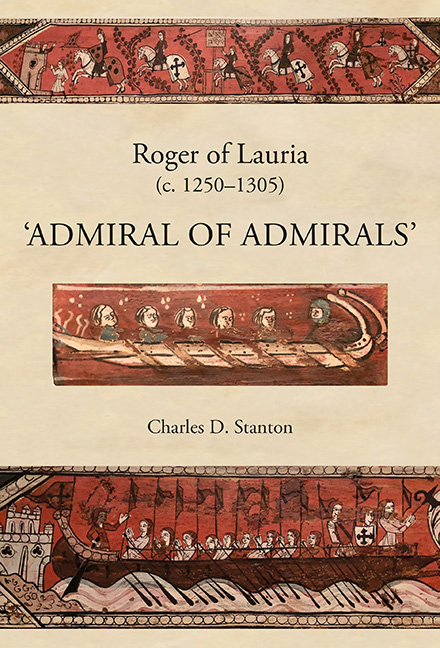Book contents
- Frontmatter
- Dedication
- Contents
- List of Illustrations
- Prologue
- 1 Battle of Benevento (26 February 1266)
- 2 A Calabrian Exile in the Court of Aragon (1262–1282)
- 3 Battle of Tagliacozzo (23 August 1268)
- 4 Aragonese Expansion (1229–1282)
- 5 Angevin Consolidation and Aggrandizement (1268–1282)
- 6 Revolt of the Vespers (30 March 1282)
- 7 Aragonese Intervention (August–October 1282)
- 8 Stalemate (November 1282–March 1283)
- 9 Admiral of Aragon (20 April 1283)
- 10 The Opposing Fleets (1282–1302)
- 11 Battle of Malta (8 June 1283)
- 12 Anjou's Dreams of Empire Dashed (June–November 1284)
- 13 France's Crusade Against Aragon (May–November 1285)
- 14 Battle of the Counts (23 June 1287)
- 15 Truces and Treaties (June 1287–November 1291)
- 16 Raid on Romania (Summer 1292)
- 17 Switching Sides (December 1293–April 1297)
- 18 Aragon's Invasion of Sicily at Anjou's Bidding (1298/1299)
- 19 Lauria's Last Great Campaign (Summer 1299–Spring 1300)
- 20 Endgame (Spring 1301–Summer 1302)
- Epilogue
- Bibliography
- Index
13 - France's Crusade Against Aragon (May–November 1285)
Published online by Cambridge University Press: 24 October 2019
- Frontmatter
- Dedication
- Contents
- List of Illustrations
- Prologue
- 1 Battle of Benevento (26 February 1266)
- 2 A Calabrian Exile in the Court of Aragon (1262–1282)
- 3 Battle of Tagliacozzo (23 August 1268)
- 4 Aragonese Expansion (1229–1282)
- 5 Angevin Consolidation and Aggrandizement (1268–1282)
- 6 Revolt of the Vespers (30 March 1282)
- 7 Aragonese Intervention (August–October 1282)
- 8 Stalemate (November 1282–March 1283)
- 9 Admiral of Aragon (20 April 1283)
- 10 The Opposing Fleets (1282–1302)
- 11 Battle of Malta (8 June 1283)
- 12 Anjou's Dreams of Empire Dashed (June–November 1284)
- 13 France's Crusade Against Aragon (May–November 1285)
- 14 Battle of the Counts (23 June 1287)
- 15 Truces and Treaties (June 1287–November 1291)
- 16 Raid on Romania (Summer 1292)
- 17 Switching Sides (December 1293–April 1297)
- 18 Aragon's Invasion of Sicily at Anjou's Bidding (1298/1299)
- 19 Lauria's Last Great Campaign (Summer 1299–Spring 1300)
- 20 Endgame (Spring 1301–Summer 1302)
- Epilogue
- Bibliography
- Index
Summary
NEITHER THE DEMISE OF CHARLES of Anjou nor the continued incarceration of his son and heir brought the bloody conflict to a conclusion. The combustible forces that had ignited it had not yet abated, much less dissipated. The impetus for dynastic territorial expansion, papal power politics and the Sicilian aspiration for some level of self-determination continued to rage like a conflagration burning out of control, consuming all before it.
The war merely entered a brutally destructive new phase, while sustaining a temporary change of venue from the Italian peninsula to the Iberian. The prize in contention was the very Crown of Aragon itself. As was previously noted, Pope Martin IV declared Peter III, whom he had excommunicated on 13 January 1283, forfeit of his kingdom at Orvieto on 21 March. He followed it up in August by dispatching legate Jean de Cholet of Saint Cecilia to Paris to offer the throne of Aragon to Charles of Valois, the third son of King Philip III of France. Philip formally accepted on 2 February 1284 and the papal legate, with all due ceremony and solemnity, invested the young prince with the Crown of Aragon on 27 February. Of course, it would not be as easy as all that to actually claim the crown. Philip and his papal patron realized that Peter was unlikely to relinquish the throne without registering a strong objection, that is, the French would have to take it by force. Accordingly, Pope Martin issued a papal bull on 3 May, formally installing Charles of Valois as King of Aragon and, the following month, he officially proclaimed a crusade to wrest the reins of power from Peter, the excommunicate.
PHILIP'S INVASION OF CATALONIA (SPRING 1285)
Pope Martin passed away in Perugia on 28 March of the following year (1285), but what he had set in motion had taken on a momentum of its own. By the second Sunday after Easter (mid-April 1285), Philip had mustered a massive army at Toulouse. In order to do so, he had collected church tithes with papal permission, heavily taxed his own feudal aristocracy and even borrowed 10,000 livres tournois from the bankers of Bruges. According to Bernat Desclot, the effort produced ‘the most mighty army that the crown of France had gathered together in that part within a hundred years’.
- Type
- Chapter
- Information
- Roger of Lauria (c.1250–1305)‘Admiral of Admirals’, pp. 177 - 197Publisher: Boydell & BrewerPrint publication year: 2019



